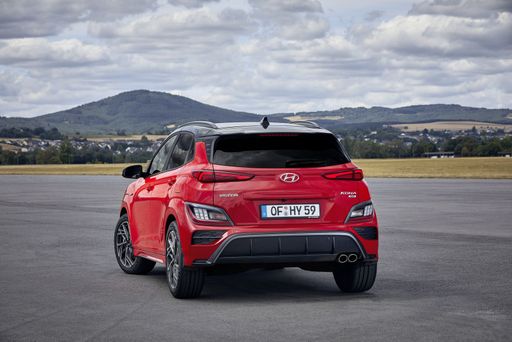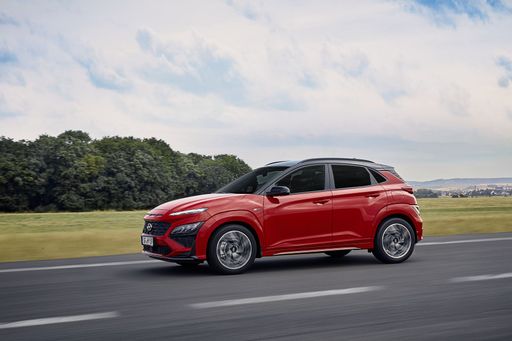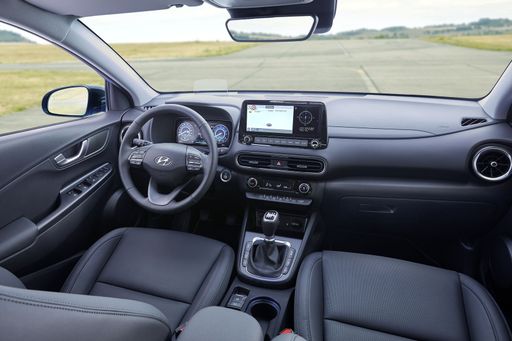Hyundai Kona vs Nissan Micra – Differences & prices compared
Both models have their strengths – but which one suits you more?
Compare performance, efficiency, price and space directly: Hyundai Kona or Nissan Micra?
Costs and Efficiency:
Price and efficiency are key factors when choosing a car – and this is often where the real differences emerge.
Hyundai Kona has a minimal advantage in terms of price – it starts at 23100 £, while the Nissan Micra costs 24000 £. That’s a price difference of around 934 £.
In terms of energy consumption, the advantage goes to the Nissan Micra: with 14.20 kWh per 100 km, it’s slight more efficient than the Hyundai Kona with 14.60 kWh. That’s a difference of about 0.40 kWh.
As for range, the Hyundai Kona performs somewhat better – achieving up to 514 km, about 98 km more than the Nissan Micra.
Engine and Performance:
Power, torque and acceleration say a lot about how a car feels on the road. This is where you see which model delivers more driving dynamics.
When it comes to engine power, the Hyundai Kona has a clearly perceptible edge – offering 218 HP compared to 150 HP. That’s roughly 68 HP more horsepower.
In acceleration from 0 to 100 km/h, the Hyundai Kona is minimal quicker – completing the sprint in 7.80 s, while the Nissan Micra takes 8 s. That’s about 0.20 s faster.
In terms of top speed, the Hyundai Kona performs clearly perceptible better – reaching 210 km/h, while the Nissan Micra tops out at 150 km/h. The difference is around 60 km/h.
There’s also a difference in torque: Hyundai Kona pulls hardly perceptible stronger with 265 Nm compared to 245 Nm. That’s about 20 Nm difference.
Space and Everyday Use:
Beyond pure performance, interior space and usability matter most in daily life. This is where you see which car is more practical and versatile.
Both vehicles offer seating for 5 people.
In curb weight, Hyundai Kona is hardly perceptible lighter – 1370 kg compared to 1452 kg. The difference is around 82 kg.
In terms of boot space, the Hyundai Kona offers clearly perceptible more room – 466 L compared to 326 L. That’s a difference of about 140 L.
In maximum load capacity, the Hyundai Kona performs slightly better – up to 1300 L, which is about 194 L more than the Nissan Micra.
When it comes to payload, Hyundai Kona a bit takes the win – 490 kg compared to 408 kg. That’s a difference of about 82 kg.
Who comes out on top?
Overall, the Hyundai Kona shows itself to be wins the duel decisively and secures the title of DriveDuel Champion.
It convinces with the more balanced overall package and proves to be the more versatile choice for everyday use.

Hyundai Kona
Hyundai Kona
The Hyundai Kona blends a bold design with a versatile interior, making it a standout choice in the compact SUV market. Its crisp handling and responsive steering provide an engaging driving experience, whether in the city or on the open road. The vehicle also offers a range of features designed to enhance comfort and connectivity, ensuring a pleasurable journey for both driver and passengers.
details @ hyundai.news
@ hyundai.news
 @ hyundai.news
@ hyundai.news
 @ hyundai.news
@ hyundai.news
 @ hyundai.news
@ hyundai.news
Nissan Micra
The Nissan Micra is a compact hatchback renowned for its agile handling and city-friendly dimensions. With a design that blends sleek curves with a practical layout, it appeals to urban drivers who value style and efficiency. Inside, the car offers a surprising amount of room and useful tech features, making it both a convenient and comfortable ride for daily commutes.
details

|
|
|
|
|
Costs and Consumption |
|
|---|---|
|
Price
23100 - 41600 £
|
Price
24000 - 29900 £
|
|
Consumption L/100km
4.6 - 7 L
|
Consumption L/100km
-
|
|
Consumption kWh/100km
14.6 - 16.8 kWh
|
Consumption kWh/100km
14.2 - 14.7 kWh
|
|
Electric Range
377 - 514 km
|
Electric Range
317 - 416 km
|
|
Battery Capacity
1.3 - 65.4 kWh
|
Battery Capacity
40 - 52 kWh
|
|
co2
0 - 163 g/km
|
co2
0 g/km
|
|
Fuel tank capacity
38 - 47 L
|
Fuel tank capacity
-
|
Dimensions and Body |
|
|---|---|
|
Body Type
SUV
|
Body Type
Hatchback
|
|
Seats
5
|
Seats
5
|
|
Doors
5
|
Doors
5
|
|
Curb weight
1370 - 1773 kg
|
Curb weight
1452 - 1527 kg
|
|
Trunk capacity
466 L
|
Trunk capacity
326 L
|
|
Length
4350 - 4385 mm
|
Length
3974 mm
|
|
Width
1825 mm
|
Width
1774 mm
|
|
Height
1580 - 1585 mm
|
Height
1490 mm
|
|
Max trunk capacity
1300 L
|
Max trunk capacity
1106 L
|
|
Payload
420 - 490 kg
|
Payload
403 - 408 kg
|
Engine and Performance |
|
|---|---|
|
Engine Type
Electric, Petrol, Full Hybrid
|
Engine Type
Electric
|
|
Transmission
Automatic, Manuel
|
Transmission
Automatic
|
|
Transmission Detail
Manual Gearbox, Dual-Clutch Automatic
|
Transmission Detail
Reduction Gearbox
|
|
Drive Type
Front-Wheel Drive, All-Wheel Drive
|
Drive Type
Front-Wheel Drive
|
|
Power HP
115 - 218 HP
|
Power HP
122 - 150 HP
|
|
Acceleration 0-100km/h
7.8 - 11.9 s
|
Acceleration 0-100km/h
8 - 9 s
|
|
Max Speed
162 - 210 km/h
|
Max Speed
150 km/h
|
|
Torque
200 - 265 Nm
|
Torque
225 - 245 Nm
|
|
Number of Cylinders
3 - 4
|
Number of Cylinders
-
|
|
Power kW
85 - 160 kW
|
Power kW
90 - 110 kW
|
|
Engine capacity
998 - 1598 cm3
|
Engine capacity
-
|
General |
|
|---|---|
|
Model Year
2024 - 2025
|
Model Year
2026
|
|
CO2 Efficiency Class
A, D, C, E, F
|
CO2 Efficiency Class
A
|
|
Brand
Hyundai
|
Brand
Nissan
|
Is the Hyundai Kona offered with different drivetrains?
Available configurations include Front-Wheel Drive or All-Wheel Drive.
The prices and data displayed are estimates based on German list prices and may vary by country. This information is not legally binding.
